Methods for Advanced Wind Turbine Condition Monitoring and Early Diagnosis: A Literature Review
Abstract
1. Introduction
2. The Basics of Wind Turbine System
3. Faults of Wind Turbine System
3.1. Rotor
3.2. Gearbox
3.3. Main Shaft
3.4. Hydraulic System
3.5. Mechanical Brake
3.6. Tower
3.7. Electric Machine
3.8. Power Electronic Converter
3.9. Sensors
3.10. Control System
4. Signals of Wind Turbine Condition Monitoring System
4.1. Vibration
4.2. Acoustic Emission
4.3. Strain
4.4. Torque and Bending Moment
4.5. Temperature
4.6. Lubrication Oil Parameters
4.7. Non-Destructive Testing
4.8. Eelectrical Signal-Based Methods
5. Signal Processing Methods
5.1. Hilbert Transform
5.2. Envelope Analysis
5.3. Statistical Analysis
5.4. Fast Fourier Transform (FFT)
5.5. Synchronous Sampling
5.6. Short Term Fourier Transform (STFT)
5.7. Wavelet Transform
5.8. Model Based Methods
5.9. Bayesian Method
5.10. Artificial Intelligence Applications
6. Conclusions
Author Contributions
Funding
Conflicts of Interest
References
- Global Wind Report 2016—Annual Market Update. Global Wind Energy Council. Available online: http://gwec.net/publications/global-wind-report-2/global-wind-report-2016/ (accessed on 14 May 2018).
- Kane, T. Clean Energy Australia Report. Clean Energy Council. Available online: https://www.cleanenergycouncil.org.au/policy-advocacy/reports/clean-energy-australia-report.html (accessed on 14 May 2018).
- Qian, P.; Ma, X.; Cross, P. Integrated data-driven model-based approach to condition monitoring of the wind turbine gearbox. IET Renew. Power Gener. 2017, 11, 1177–1185. [Google Scholar] [CrossRef]
- Bakar, N.A.; Abu-Siada, A.; Islam, S.; El-Naggar, M. A New Technique to Measure Interfacial Tension of Transformer Oil using UV-Vis Spectroscopy. IEEE Trans. Dielectr. Electr. Insul. 2015, 22, 1275–1282. [Google Scholar] [CrossRef]
- Abu-Siada, A.; Hamood, S. A New Fuzzy Logic Approach to Identify Power Transformer Criticality using Dissolved Gas-in-Oil Analysis. Int. J. Electr. Power Energy Syst. 2015, 67, 401–408. [Google Scholar] [CrossRef]
- Abu-Siada, A.; Arshad, M.; Islam, S. Fuzzy Logic Approach to Identify Transformer Criticality using Dissolved Gas Analysis. In Proceedings of the 2010 IEEE PES General Meeting, Providence, RI, USA, 25–29 July 2010. [Google Scholar]
- Hashemnia, N.; Abu-Siada, A.; Mohammad, A.S.M.; Islam, S.M. Characterization of Transformer FRA Signature under Various Winding Faults. In Proceedings of the 2012 International Conference on Condition Monitoring and Diagnosis conference, Bali, Indonesia, 23–27 September 2012. [Google Scholar]
- Hashemnia, N.; Abu-Siada, A.; Islam, S. Detection of Power Transformer Bushing Faults and Oil Degradation using Frequency Response Analysis. IEEE Trans. Dielectr. Electr. Insul. 2016, 23, 222–229. [Google Scholar] [CrossRef]
- Tchakoua, P.; Wamkeue, R.; Tameghe, T.A.; Ekemb, G. A review of concepts and methods for wind turbines condition monitoring. In Proceedings of the World Congress on Computer and Information Technology (WCCIT), Sousse, Tunisia, 22–24 June 2013; pp. 1–9. [Google Scholar]
- Qiao, W.; Lu, D. A Survey on Wind Turbine Condition Monitoring and Fault Diagnosis—Part I: Components and Subsystems. IEEE Trans. Ind. Electron. 2015, 62, 6536–6545. [Google Scholar] [CrossRef]
- Hasanien, H.M.; Muyeen, S.M. Affine projection algorithm based adaptive control scheme for operation of variable-speed wind generator. IET Gener. Transm. Distrib. 2015, 9, 2611–2616. [Google Scholar] [CrossRef]
- Yunus, M.S.; Masoum, M.A.S.; Abu-Siada, A. Application of SMES to Enhance the Dynamic Performance of DFIG during Voltage Sag and Swell. IEEE Trans. Appl. Supercond. 2012, 22. [Google Scholar] [CrossRef]
- Joseph, A.; Chelliah, T.R. A Review of Power Electronic Converters for Variable Speed Pumped Storage Plants: Configurations, Operational Challenges and Future Scopes. IEEE J. Emerg. Sel. Top. Power Electron. 2017, PP, 103–119. [Google Scholar] [CrossRef]
- Rouco, L.; Chan, K.; Oesterheld, J.; Keller, S. Recent evolution of European grid code requirements and its impact on turbogenerator design. In Proceedings of the IEEE Power Energy Society General Meeting, San Diego, CA, USA, 22–26 July 2012; pp. 1–9. [Google Scholar]
- Hasanien, H.M.; Muyeen, S.M. Design Optimization of Controller Parameters Used in Variable Speed Wind Energy Conversion System by Genetic Algorithms. IEEE Trans. Sustain. Energy 2012, 3, 200–208. [Google Scholar] [CrossRef]
- Alharbi, Y.M.; Yunus, A.M.S.; Abu-Siada, A. Application of UPFC to Improve the LVRT Capability of Wind Turbine Generator. In Proceedings of the 2012 22nd Australasian Universities, Power Engineering Conference (AUPEC), Bali, Indonesia, 26–29 September 2012. [Google Scholar]
- Yunus, A.M.S.; Abu-Siada, A.; Masoum, M.A.S. Application of STATCOM to Improve the Low-Voltage-Ride-Through Capability of Type-D Wind Turbine Generator. In Proceedings of the IEEE Innovation Smart Grid Technologies conference, Perth, WA, Australia, 13–16 November 2011. [Google Scholar]
- Hahn, B.; Durstewitz, M.; Rohrig, K. Reliability of Wind Turbines. In Wind Energy; Springer: Berlin/Heidelberg, Germany, 2007; pp. 329–332. [Google Scholar]
- Malik, H.; Mishra, S. Artificial neural network and empirical mode decomposition based imbalance fault diagnosis of wind turbine using TurbSim, FAST and Simulink. IET Renew. Power Gener. 2017, 11, 889–902. [Google Scholar] [CrossRef]
- Zeng, J.; Lu, D.; Zhao, Y.; Zhang, Z.; Qiao, W.; Gong, X. Wind turbine fault detection and isolation using support vector machines and residual-based method. In Proceedings of the American Control Conference, Washington, DC, USA, 17–19 June 2013; pp. 3661–3666. [Google Scholar]
- Helander, J.; Ericsson, A.; Gustafsson, M.; Martin, T.; Sjöberg, D.; Larsson, C. Compressive Sensing Techniques for mm-Wave Non-Destructive Testing of Composite Panels. IEEE Trans. Antennas Propag. 2017, 65, 5523–5531. [Google Scholar] [CrossRef]
- Campbell, S. Annual Blade Failures Estimated at Around 3800. Available online: http://www.windpowermonthly.com/article/1347145/annual-blade-failures-estimated-round-3800 (accessed on 16 May 2018).
- Salem, A.; Abu-Siada, A.; Islam, S. Improved condition monitoring technique for wind turbine gearbox and shaft stress detection. IET Sci., Meas. Technol. 2017, 11, 431–437. [Google Scholar] [CrossRef]
- Blancke, O.; Merkhouf, A.; Amyot, N.; Pedneault-Desroches, J.; Hudon, C.; Haddad, K. Strategic fault diagnosis approach for hydrogenerator shaft current discharges. In Proceedings of the XXII International Conference on Electrical Machines (ICEM), Lausanne, Switzerland, 4–7 September 2016; pp. 2346–2351. [Google Scholar]
- Marzebali, M.H.; Kia, S.H.; Henao, H.; Capolino, G.A.; Faiz, J. Planetary Gearbox Torsional Vibration Effects on Wound-Rotor Induction Generator Electrical Signatures. IEEE Trans. Ind. Appl. 2016, 52, 4770–4780. [Google Scholar] [CrossRef]
- Wu, X.; Li, Y.; Li, F.; Yang, Z.; Teng, W. Adaptive estimation based leakage detection for a wind turbine hydraulic pitching system. IEEE/ASME Trans. Mech. 2012, 17, 907–914. [Google Scholar] [CrossRef]
- Wang, L.; Wen, C. Fault diagnosis of wind turbine blade based on robust residual error design. In Proceedings of the 2016 Chinese Control and Decision Conference (CCDC), Yinchuan, China, 28–30 May 2016; pp. 574–577. [Google Scholar]
- Entezami, M.; Hillmansen, S.; Weston, P.; Papaelias, M.P. Fault detection and diagnosis within a wind turbine mechanical braking system using condition monitoring. Renew. Energy 2012, 47, 175–182. [Google Scholar] [CrossRef]
- Kilic, G.; Unluturk, M.S. Testing of wind turbine towers using wireless sensor network and accelerometer. Renew. Energy 2015, 75, 318–325. [Google Scholar] [CrossRef]
- Yucai, W.; Yonggang, L. Diagnosis of short circuit faults within turbo generator excitation winding based on the expected electromotive force method. IEEE Trans. Energy Convers. 2016, 31, 706–713. [Google Scholar] [CrossRef]
- Qiao, W.; Lu, D. A Survey on Wind Turbine Condition Monitoring and Fault Diagnosis—Part II: Signals and Signal Processing Methods. IEEE Trans. Ind. Electron. 2015, 62, 6546–6557. [Google Scholar] [CrossRef]
- Djurovic, S.; Williamson, S.; Yang, W.; Tavner, P. Condition monitoring artifacts for detecting winding faults in wind turbine DFIGs. In Proceedings of the European Wind Energy Conference & Exhibition, Marseille, France, 16–19 March 2009; pp. 1–6. [Google Scholar]
- Wang, H.; Liserre, M.; Blaabjerg, F. Toward reliable power electronics: Challenges, design tools, and opportunities. IEEE Ind. Electron. Mag. 2013, 7, 17–26. [Google Scholar] [CrossRef]
- Ran, L.; Konaklieva, S.; McKeever, P.; Mawby, P. Condition monitoring of power electronics for offshore wind. IET Eng. Technol. Ref. 2014, 1, 1–10. [Google Scholar] [CrossRef]
- Ribrant, J.; Bertling, L.M. Survey of failures in wind power systems with focus on Swedish wind power plants during 1997–2005. IEEE Trans. Energy Convers. 2007, 22, 167–173. [Google Scholar] [CrossRef]
- Sepe, R.B., Jr.; Miller, J.M. Fault tolerant operation of induction motor drives with automatic controller reconfiguration. In Proceedings of the IEEE International Electric Machines and Drives Conference, Cambridge, MA, USA, 17–20 June 2001; pp. 156–162. [Google Scholar]
- Bourogaoui, M.; Berriri, H.; Attia-Sethom, H.B.; Slama-Belkhodja, I. Wavelets and parity equations methods comparison for faulty encoder detection in PMSM drives. In Proceedings of the 8th International Multi-Conference on Systems, Signals and Devices, Sousse, Tunisia, 22–25 March 2011; pp. 1–7. [Google Scholar]
- Wang, J.; Peng, Y.; Qiao, W. Current-Aided Order Tracking of Vibration Signals for Bearing Fault Diagnosis of Direct-Drive Wind Turbines. IEEE Trans. Ind. Electron. 2016, 63, 6336–6346. [Google Scholar] [CrossRef]
- Caselitz, P.; Giebhardt, J. Rotor condition monitoring for improved operational safety of offshore wind energy converters. J. Sol. Energy Eng. 2005, 127, 253–261. [Google Scholar] [CrossRef]
- Sorensen, B.F.; Rheinländer, J.; Rusborg, J. Fundamentals for Remote Structural Health Monitoring of Wind Turbine Blades—A Preproject; Tech. Rep. Risø-R-1336(EN); Riso Nat. Lab.: Roskilde, Denmark, 2002. [Google Scholar]
- Yang, W.; Peng, Z.; Wei, K.; Tian, W. Structural health monitoring of composite wind turbine blades: Challenges, issues and potential solutions. IET Renew. Power Gener. 2017, 11, 411–416. [Google Scholar] [CrossRef]
- Lu, B.; Li, Y.; Wu, X.; Yang, Z. A review of recent advances in wind turbine condition monitoring and fault diagnosis. In Proceedings of the 2009 IEEE Power Electronics and Machines in Wind Applications, Lincoln, NE, USA, 24–26 June 2009; pp. 1–7. [Google Scholar]
- Yang, W.; Lang, Z.; Tian, W. Condition Monitoring and Damage Location of Wind Turbine Blades by Frequency Response Transmissibility Analysis. IEEE Trans. Ind. Electron. 2015, 62, 6558–6564. [Google Scholar] [CrossRef]
- Lading, L.; McGugan, M.; Sendrup, P.; Rheinlander, J.; Rusborg, J. Fundamentals for Remote Structural Health Monitoring of Wind Turbine Blades—A Pre-Project: Annex B—Sensors and Non-Destructive Testing Methods for Damage Detection in Wind Turbine Blades; Tech. Rep. Risø-R-1341(EN); Riso Nat. Lab.: Roskilde, Denmark, 2002. [Google Scholar]
- Wilkinson, M.R.; Spinato, F.; Tavner, P.J. Condition monitoring of generators and other subassemblies in wind turbine drive trains. In Proceedings of the IEEE International Symposium on Diagnostics for Electric Machines, Power Electronics and Drives, Cracow, Australia, 6–8 September 2007; pp. 388–392. [Google Scholar]
- Zaher, S.; McArthur, S.D.J. A multi-agent fault detection system for wind turbine defect recognition and diagnosis. In Proceedings of the IEEE Lausanne Power Tech, Lausanne, Switzerland, 1–5 July 2007; pp. 22–27. [Google Scholar]
- Qiu, Y.; Feng, Y.; Sun, J.; Zhang, W.; Infield, D. Applying thermophysics for wind turbine drivetrain fault diagnosis using SCADA data. IET Renew. Power Gener. 2016, 10, 661–668. [Google Scholar] [CrossRef]
- Qiu, Y.; Zhang, W.; Cao, M.; Feng, Y.; Infield, D. An Electro-Thermal Analysis of a Variable-Speed Doubly-Fed Induction Generator in a Wind Turbine. Energies 2015, 8, 3386–3402. [Google Scholar] [CrossRef]
- Astolfi, D.; Castellani, F.; Terzi, L. Fault Prevention and Diagnosis through Scada Temperature. Diagnostyka 2014, 15, 71–78. [Google Scholar]
- Sun, P.; Li, J.; Wang, C.; Lei, X. A generalized model for wind turbine anomaly identification based on SCADA data. Appl. Energy 2016, 168, 550–567. [Google Scholar] [CrossRef]
- Sheng, S. Investigation of oil conditioning, real-time monitoring and oil sample analysis for wind turbine gearboxes. In Proceedings of the AWEA Project Performance and Reliability Workshop, San Diego, CA, USA, 12–23 January 2011. [Google Scholar]
- Liu, W.; Tang, B.; Jiang, Y. Status and problems of wind turbine structural health monitoring techniques in China. Renew. Energy 2010, 35, 1414–1418. [Google Scholar] [CrossRef]
- Popa, L.M.; Jensen, B.B.; Ritchie, E.; Boldea, I. Condition monitoring of wind generators. In Proceedings of the IAS Annual Meeting on Conference Record of the Industry, Salt Lake City, UT, USA, 12–16 October 2003; pp. 1839–1846. [Google Scholar]
- Bennouna, O.; Heraud, N.; Camblong, H.; Rodriguez, M. Diagnosis of the doubly-fed induction generator of a wind turbine. Wind Eng. 2005, 29, 431–447. [Google Scholar] [CrossRef]
- Yang, W.; Tavner, P.J.; Crabtree, C.J.; Wilkinson, M. Research on a simple, cheap but globally effective condition monitoring technique for wind turbines. In Proceedings of the International Conference on Electrical Machines, Vilamoura, Portugal, 6–9 September 2008; pp. 1–5. [Google Scholar]
- Lu, D.; Qiao, W.; Gong, X. Current-Based Gear Fault Detection for Wind Turbine Gearboxes. IEEE Trans. Sustain. Energy 2017, 8, 1453–1462. [Google Scholar] [CrossRef]
- Trilla, L.; Pegueroles, J.; Urresty, J.; Muniz, C.; Gomis-Bellmunt, O. Generator Short-Circuit Torque Compensation in Multichannel Wind Turbines. IEEE Trans. Ind. Electron. 2017, 64, 8790–8798. [Google Scholar] [CrossRef]
- Jeffries, W.Q.; Chambers, J.A.; Infield, D.G. Experience with bi-coherence of electrical power for condition monitoring of wind turbine blades. Proc. Inst. Elect. Eng. Vis. Image Signal Process. 1998, 145, 141–148. [Google Scholar] [CrossRef]
- Watson, S.; Xiang, J. Real-time condition monitoring of offshore wind turbines. In Proceedings of the European Wind Energy Conference, Athènes, Greece, 27 February–2 March 2006; pp. 647–654. [Google Scholar]
- Wang, Z.; Guo, Q. The diagnosis method for converter fault of the variable speed wind turbine based on the neural networks. In Proceedings of the 2nd International Conference on Innovative Computing, Informatio and Control, Kumamoto, Japan, 5–7 September 2007; p. 615. [Google Scholar]
- Lu, D.; Qiao, W. Current-based fault detection for wind turbine systems via Hilbert-Huang transform. In Proceedings of the IEEE Power & Energy Society General Meeting, Vancouver, BC, Canada, 21–25 July 2013; pp. 1–5. [Google Scholar]
- Gong, X.; Qiao, W. Current-based mechanical fault detection for direct-drive wind turbines via synchronous sampling and impulse detection. IEEE Trans. Ind. Electron. 2015, 62, 1693–1702. [Google Scholar] [CrossRef]
- An, X.; Jiang, D.; Li, S.; Zhao, M. Application of the ensemble empirical mode decomposition and Hilbert transform to pedestal looseness study of direct-drive wind turbine. Energy 2011, 36, 5508–5520. [Google Scholar] [CrossRef]
- Weller, N. Acceleration Enveloping—Higher Sensitivity, Earlier Detection. Available online: https://pdfs.semanticscholar.org/db43/651ab5ec66c49b48441512c3354b835ed385.pdf (accessed on 14 May 2018).
- Jones, R.M. Enveloping for bearing analysis. Sound Vib. 1996, 30, 10–15. [Google Scholar]
- Asian, S.; Ertek, G.; Haksoz, C.; Pakter, S.; Ulun, S. Wind Turbine Accidents: A Data Mining Study. IEEE Syst. J. 2017, 11, 1567–1578. [Google Scholar] [CrossRef]
- Zimroz, R.; Urbanek, J.; Barszcz, T.; Bartelmus, W.; Millioz, F.; Martin, N. Measurement of instantaneous shaft speed by advanced vibration signal processing—Application to wind turbine gearbox. Metrol. Meas. Syst. 2010, 18, 701–712. [Google Scholar] [CrossRef]
- Watson, S.J.; Xiang, B.J.; Yang, W.; Tavner, P.J.; Crabtree, C.J. Condition Monitoring of the Power Output of Wind Turbine Generators Using Wavelets. IEEE Trans. Energy Convers. 2010, 25, 715–721. [Google Scholar] [CrossRef]
- Gray, C.S.; Watson, S.J. Physics of failure approach to wind turbine condition based maintenance. Wind Energy 2010, 13, 395–405. [Google Scholar] [CrossRef]
- Yang, W.; Court, R.; Jiang, J. Wind turbine condition monitoring by the approach of SCADA data analysis. Renew. Energy 2013, 53, 365–376. [Google Scholar] [CrossRef]
- Mirzaei, G.; Jamali, M.M.; Ross, J.; Gorsevski, P.V.; Bingman, V.P. Data Fusion of Acoustics, Infrared, and Marine Radar for Avian Study. IEEE Sens. J. 2015, 15, 6625–6632. [Google Scholar] [CrossRef]
- Sharma, S.; Mahto, D. Condition monitoring of wind turbine gear box. Int. J. Res. Stud. Sci. Eng. Technol. 2014, 1, 33–51. [Google Scholar]
- Zhu, J.; Yoon, J.M.; He, D.; Bechhoefer, E. Online particle- contaminated lubrication oil condition monitoring and remaining useful life prediction for wind turbines. Wind Energy 2015, 18, 1131–1149. [Google Scholar] [CrossRef]
- Wu, Y.K.; Lee, C.Y.; Chen, C.R.; Hsu, K.W.; Tseng, H.T. Optimization of the Wind Turbine Layout and Transmission System Planning for a Large-Scale Offshore Wind Farm by AI Technology. IEEE Trans. Ind. Appl. 2014, 50, 2071–2080. [Google Scholar] [CrossRef]
- Yunus, A.M.S.; Abu-Siada, A.; Masoum, M.A.S. Improving Dynamic Performance of Wind Energy Conversion System using Fuzzy-Based Hysteresis Current Controlled SMES. IET Power Electron. 2012, 5, 1305–1314. [Google Scholar] [CrossRef]
- Yunus, S.; Abu-Siada, A.; Masoum, M. Effects of SMES on Dynamic Behaviours of type D-Wind turbine Generator-Grid connected during short circuit. In Proceedings of the 2011 IEEE Power & Energy Society General Meeting, Detroit, MI, USA, 24–28 July 2011. [Google Scholar]
- Abdou, A.F.; Abu-Siada, A.; Pota, H.R. Improving the low voltage ride through of doubly fed induction generator during intermittent voltage source converter faults. J. Renew. Sustain. Energy 2013, 5. [Google Scholar] [CrossRef]
- Tchakoua, P.; Wamkeue, R.; Ouhrouche, M.; Slaoui-Hasnaoui, F.; Tameghe, T.A.; Ekemb, G. Wind turbine condition monitoring: State-of-the-art review, new trends, and future challenges. Energies 2014, 7, 2595–2630. [Google Scholar] [CrossRef]
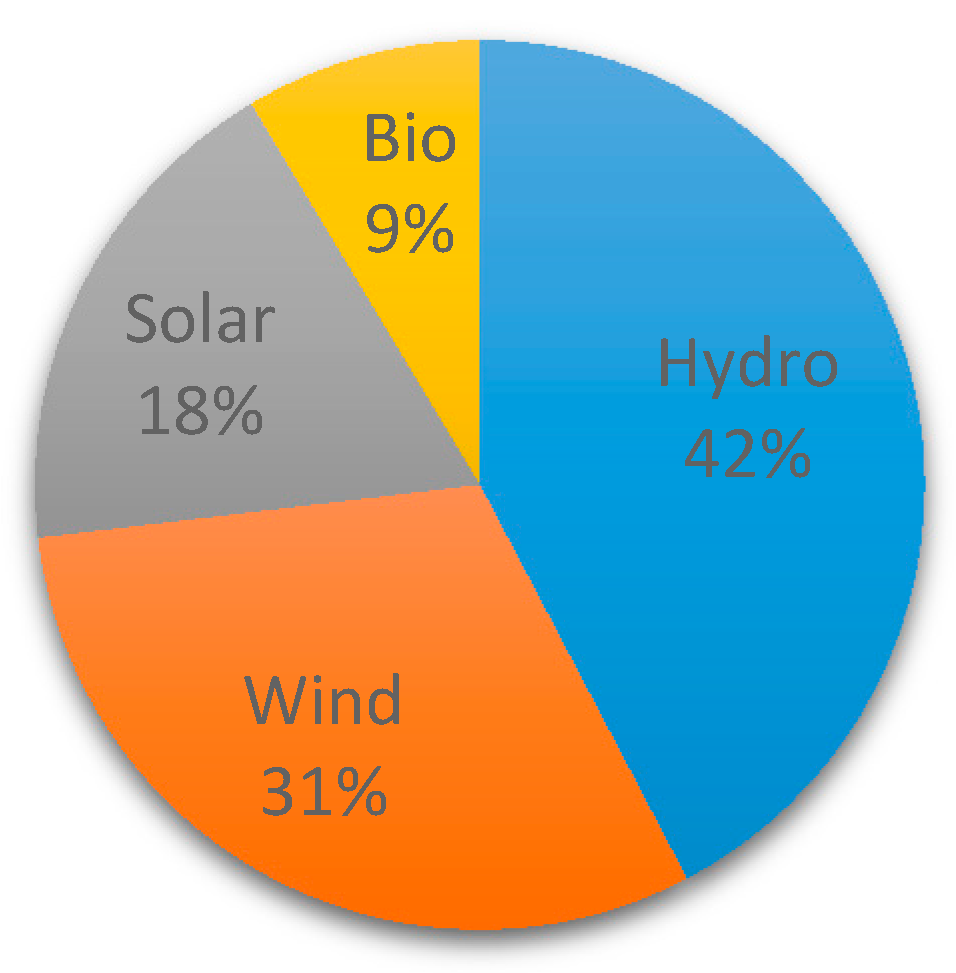
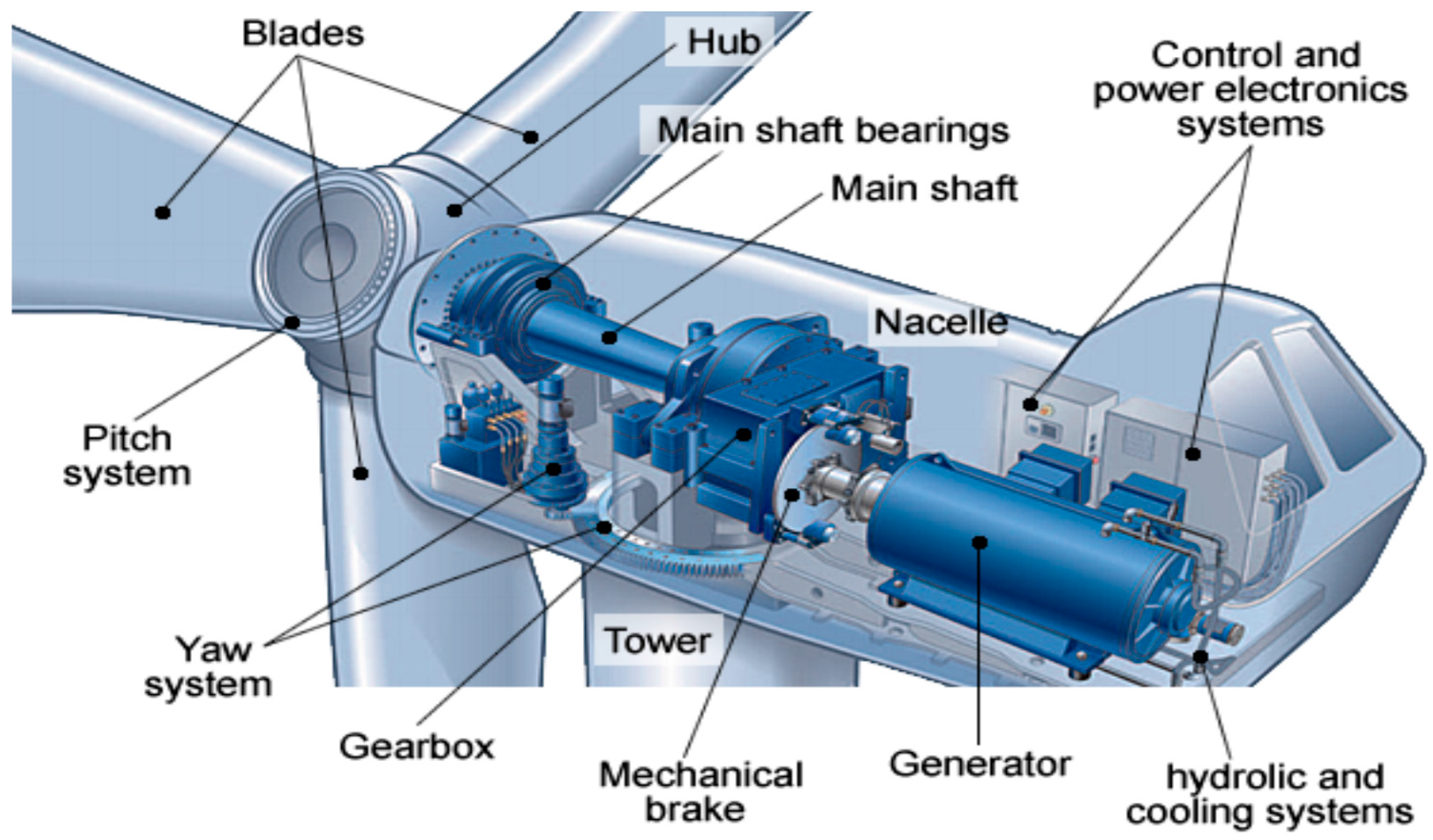
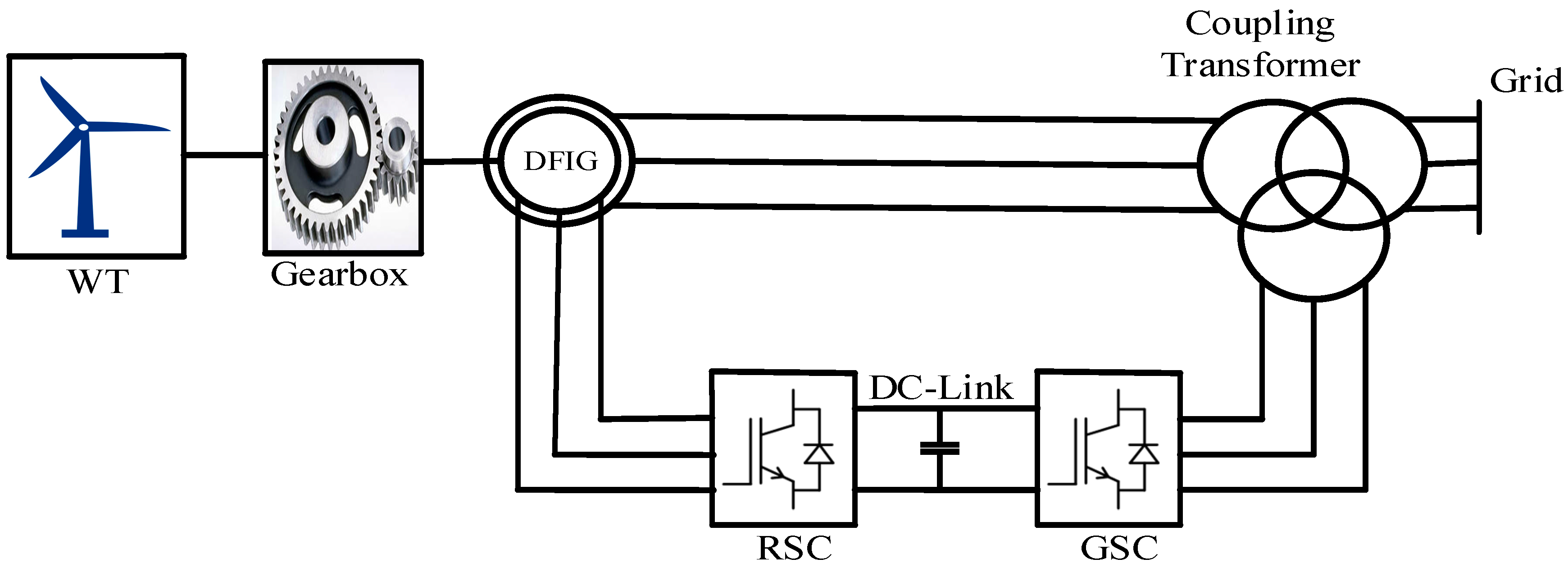
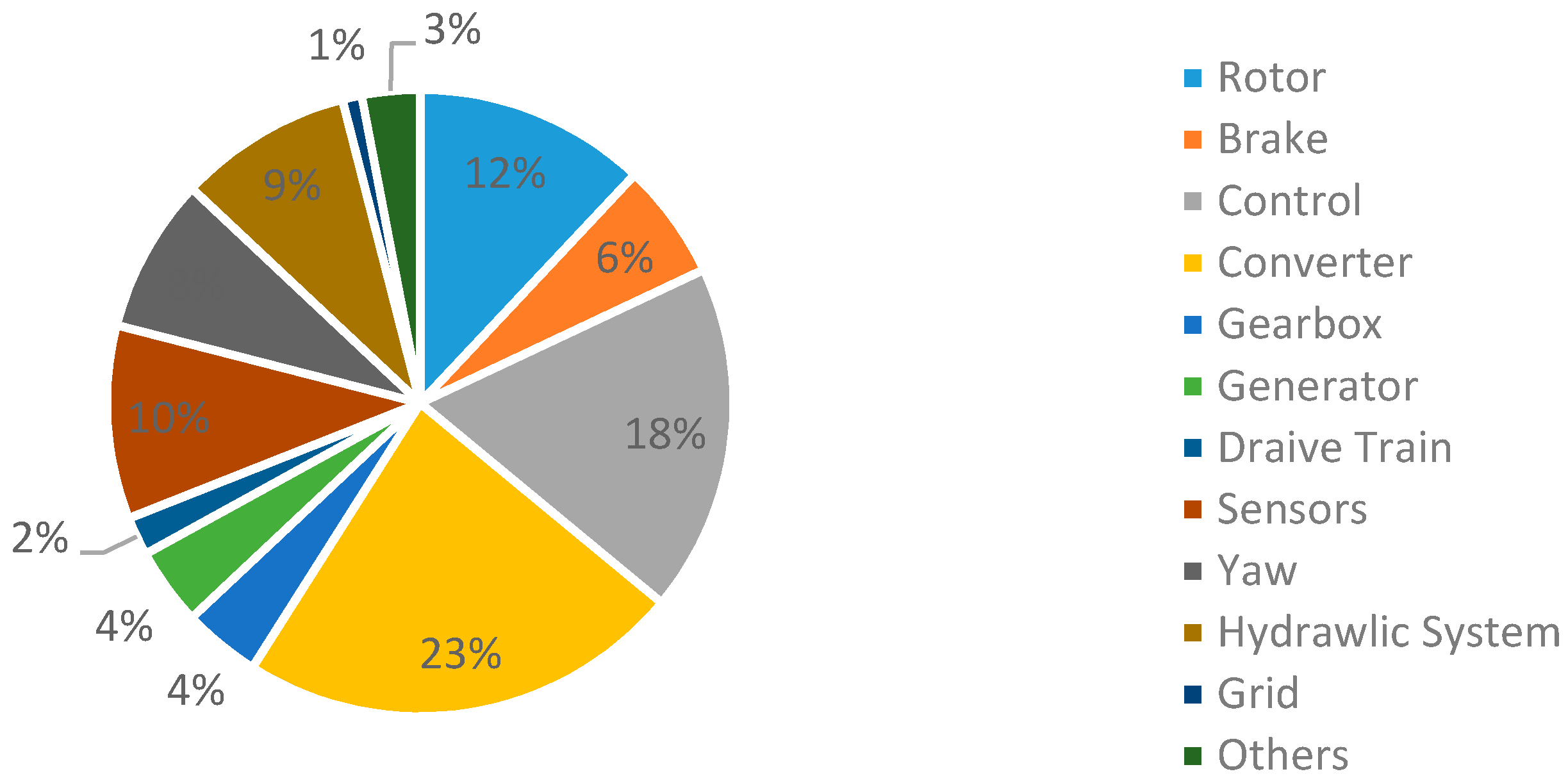
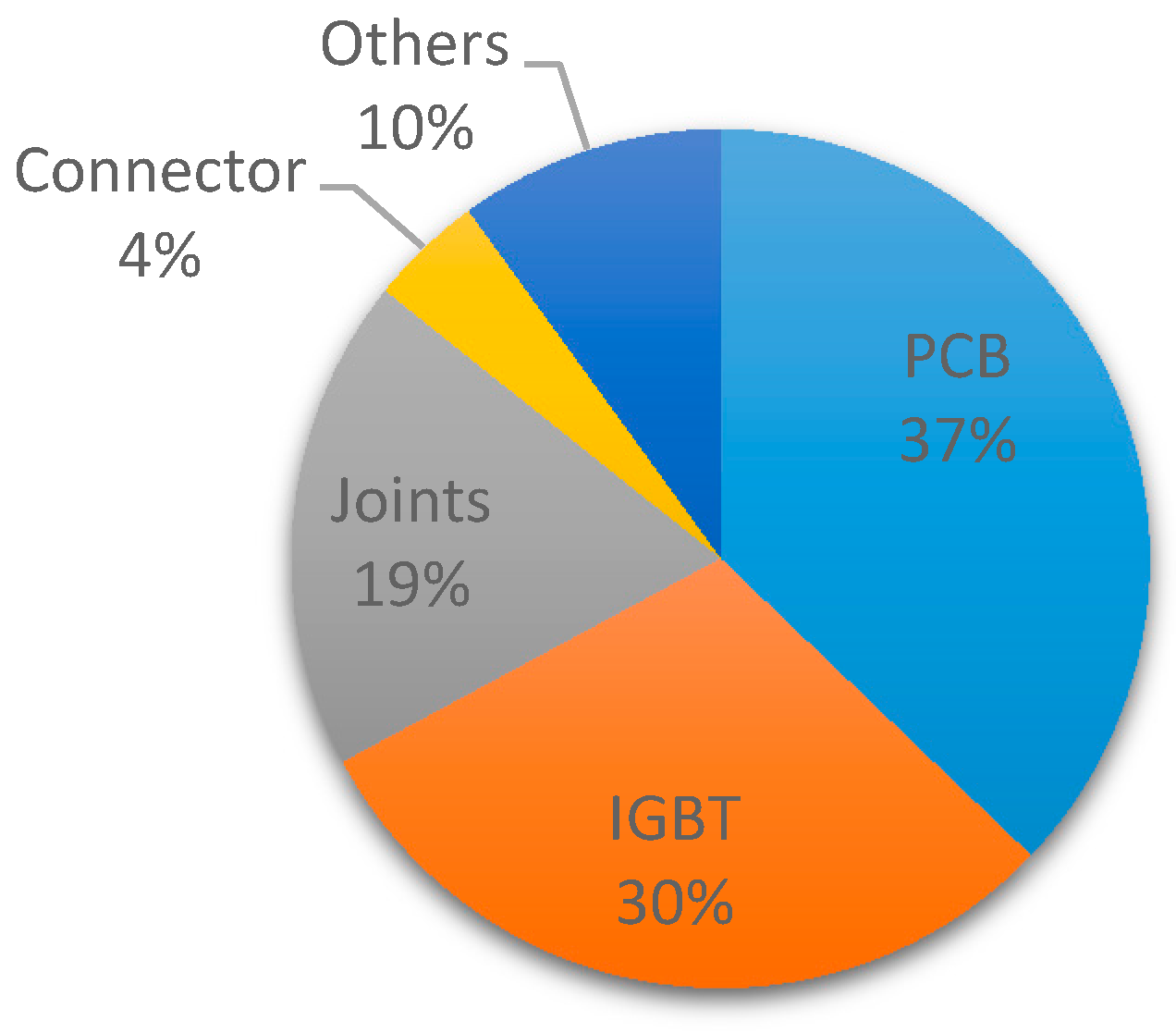
| Component/Subsystem | Faults Occurred | Signals Monitored | Signal Processing Methods |
|---|---|---|---|
| Rotor |
|
|
|
| Gearbox |
|
|
|
| Bearing |
|
|
|
| Main shaft |
|
|
|
| Hydraulic system |
| Pressure level | Threshold comparison |
| Mechanical Brake |
|
|
|
| Tower |
| Vibration |
|
| Generator |
|
|
|
| Power Converter |
|
|
|
| Sensors |
| All related signals |
|
| Control system |
| All related signals |
|
| Signals Monitored | Advantages | Limitations |
|---|---|---|
| Vibration |
|
|
| Acoustic Emission |
|
|
| Strain |
|
|
| Torque and Bending moment |
| Intrusive |
| Temperature |
|
|
| Lubrication Oil |
|
|
| Non-Destructive Testing | Ability to detect hidden damages in composite materials | Requires expensive instruments |
| Electrical Signals |
|
|
| Signal Processing Method | Function | Non-Stationary Signal Processing | Early Fault Prediction | Data Complexity | Resolution |
|---|---|---|---|---|---|
| Hilbert transform | Signal conditioning | Yes | Possible | Medium | High |
| Envelope Analysis | Feature extraction | Possible | Yes | Low/Medium | High |
| Statistical Analysis | Feature extraction | Possible | Possible | Low | Rely on input |
| FFT | Feature extraction | No | No | Medium | High |
| Synchronous sampling | Signal conditioning | Yes | Possible | Low/Medium | High |
| STFT | Feature extraction | Yes | Possible | High | Medium |
| Wavelet transform | Signal conditioning | Yes | Possible | Low/Medium | Medium |
| Model based methods | Feature extraction | Possible | Yes | Medium/High | Rely on input |
| AI | Feature extraction, diagnosis, prognosis | Possible | Possible | High | Rely on input |
| Bayesian Methods | prognosis | Possible | No | High | Rely on input |
© 2018 by the authors. Licensee MDPI, Basel, Switzerland. This article is an open access article distributed under the terms and conditions of the Creative Commons Attribution (CC BY) license (http://creativecommons.org/licenses/by/4.0/).
Share and Cite
Hossain, M.L.; Abu-Siada, A.; Muyeen, S.M. Methods for Advanced Wind Turbine Condition Monitoring and Early Diagnosis: A Literature Review. Energies 2018, 11, 1309. https://doi.org/10.3390/en11051309
Hossain ML, Abu-Siada A, Muyeen SM. Methods for Advanced Wind Turbine Condition Monitoring and Early Diagnosis: A Literature Review. Energies. 2018; 11(5):1309. https://doi.org/10.3390/en11051309
Chicago/Turabian StyleHossain, Md Liton, Ahmed Abu-Siada, and S. M. Muyeen. 2018. "Methods for Advanced Wind Turbine Condition Monitoring and Early Diagnosis: A Literature Review" Energies 11, no. 5: 1309. https://doi.org/10.3390/en11051309
APA StyleHossain, M. L., Abu-Siada, A., & Muyeen, S. M. (2018). Methods for Advanced Wind Turbine Condition Monitoring and Early Diagnosis: A Literature Review. Energies, 11(5), 1309. https://doi.org/10.3390/en11051309






